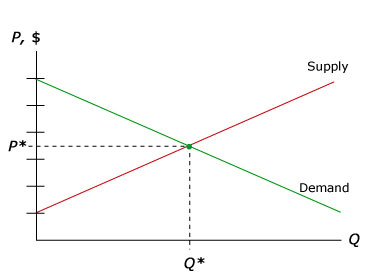There’s a commonly-held myth in software pricing. It goes like this. The more something costs, fewer people will want to buy it. Here’s the picture:
This assumption, called elasticity of demand, is true in general but is wrong for software, or at least wrong from the point of view of a small ISV.
First, demand elasticity assumes that there are a large quantity of people who want your product, if only marginally. For your average startup, this is simply not true. In reality there’s a tiny niche that wants the product, if even anyone does.
Second, demand elasticity assumes that the predominating factor in the purchasing equation is price. This is not true either. Often the predominant factor is the time investment required. When TF2 cost money, I didn’t play it, and now that it is free I still don’t play it. If Apple raised the price of Pages to $200 from $20 I might be mad, but I wouldn’t migrate. If cpervia tripled the cost of tarsnap tomorrow I would not bat an eyelash. There is no software I would stop using because of a moderate price hike. Conversely, if Dropbox became free tomorrow, I would still be searching for an alternative, and if Microsoft announced free licenses of Windows 8, I wouldn’t convert any of my machines. In the majority of cases for me, price is simply a non-factor relative to things like time investment, vendor lock in, training, etc.
 Tom hits the nail on the head when he says “if you’re taking pricing advice from people who will never pay for your service, you’re making a big mistake.” The truth is, unless you have the marketing team of Coke, you need to be selling water to people in a desert. The focus should be on people who have a problem and how your product does something that they desperately, desperately need.
Tom hits the nail on the head when he says “if you’re taking pricing advice from people who will never pay for your service, you’re making a big mistake.” The truth is, unless you have the marketing team of Coke, you need to be selling water to people in a desert. The focus should be on people who have a problem and how your product does something that they desperately, desperately need.
If you’re trying to attract people who would only use your product if it was 10x or 100x cheaper, then that product doesn’t solve any pressing problem that they have. Completely independent of the huge downside of making less money, you will have a worse product, because the vital feedback from the customers who seriously and deeply have the problem will be drowned out by the noise and the massive support headache of people who don’t.
I see this particularly in iOS software. Because the Top 100 ultra-popular apps are all $0.99, developers feel pressure for some strange reason to price their non-popular apps at most a few bucks. Unless your application directly competes with Angry Birds, and customers will be downloading Angry Birds instead of your product, the price of Angry Birds doesn’t matter. The anchor for your product pricing should be the size of the problem that it solves, not the cost of other arbitrary iOS software. If people complain about the price, good. You’ve eliminated a class of whiny customers.
A great example is the venerable OmniGroup, which in a world of $0.99 apps prices their products at $20, $40, and $80. What’s even more impressive is that their bread-and-butter product is a task manager, one of the most competitive categories in the market, and they’re charging $140 for an iPhone/iPad/Mac task manager while competitors are charging less than 1% of that. Omni is selling water to thirsty people and they’re making a killing. You should be too.
Want me to build your app / consult for your company / speak at your event? Good news! I'm an iOS developer for hire.
Like this post? Contribute to the coffee fund so I can write more like it.

 Tags
Tags 
Comments
Comments are closed.